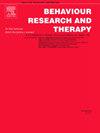Which one impacts the other?: The relationship between change in borderline personality disorder severity and change in posttraumatic stress disorder severity among individuals in dialectical behavior therapy
IF 4.5
2区 心理学
Q1 PSYCHOLOGY, CLINICAL
引用次数: 0
Abstract
Borderline personality disorder (BPD) and posttraumatic stress disorder (PTSD) commonly co-occur. Limited research, however, has examined the association between fluctuations in the severity of one disorder with fluctuations in the severity of the other disorder. In a sample of N = 240 self-harming individuals with BPD undergoing 6 or 12 months of Dialectical Behavior Therapy (DBT), we used a cross-lagged panel model with 3-month intervals to evaluate the temporal relationship between BPD severity and PTSD severity during DBT and throughout follow-up. We similarly examined the relationship in the sub-sample meeting criteria for both disorders (BPD + PTSD; N = 81). Results indicated that decreases in PTSD severity at one timepoint corresponded with decreases in BPD severity at the subsequent timepoint, and that there was minimal evidence for the reverse relationship. Findings were consistent across our analyses in both the full BPD sample and the BPD + PTSD subsample. In the context of DBT, addressing PTSD might help reduce subsequent BPD severity, but addressing BPD features might not have similar effects on PTSD severity.
哪一个会影响另一个?:辩证行为治疗中个体边缘型人格障碍严重程度变化与创伤后应激障碍严重程度变化的关系
边缘性人格障碍(BPD)和创伤后应激障碍(PTSD)通常同时发生。然而,有限的研究已经检查了一种疾病严重程度的波动与另一种疾病严重程度的波动之间的关系。在接受6或12个月辩证行为治疗(DBT)的N = 240名自我伤害的BPD患者中,我们采用间隔3个月的交叉滞后面板模型来评估DBT期间和整个随访期间BPD严重程度与PTSD严重程度的时间关系。我们同样检查了符合两种疾病(BPD + PTSD;n = 81)。结果表明,PTSD严重程度在一个时间点的降低与BPD严重程度在随后的时间点的降低相对应,并且几乎没有证据表明两者之间存在反向关系。研究结果在整个BPD样本和BPD + PTSD亚样本中都是一致的。在DBT的背景下,解决PTSD可能有助于降低后续BPD的严重程度,但解决BPD的特征可能对PTSD的严重程度没有类似的影响。
本文章由计算机程序翻译,如有差异,请以英文原文为准。
求助全文
约1分钟内获得全文
求助全文
来源期刊

Behaviour Research and Therapy
PSYCHOLOGY, CLINICAL-
CiteScore
7.50
自引率
7.30%
发文量
148
期刊介绍:
The major focus of Behaviour Research and Therapy is an experimental psychopathology approach to understanding emotional and behavioral disorders and their prevention and treatment, using cognitive, behavioral, and psychophysiological (including neural) methods and models. This includes laboratory-based experimental studies with healthy, at risk and subclinical individuals that inform clinical application as well as studies with clinically severe samples. The following types of submissions are encouraged: theoretical reviews of mechanisms that contribute to psychopathology and that offer new treatment targets; tests of novel, mechanistically focused psychological interventions, especially ones that include theory-driven or experimentally-derived predictors, moderators and mediators; and innovations in dissemination and implementation of evidence-based practices into clinical practice in psychology and associated fields, especially those that target underlying mechanisms or focus on novel approaches to treatment delivery. In addition to traditional psychological disorders, the scope of the journal includes behavioural medicine (e.g., chronic pain). The journal will not consider manuscripts dealing primarily with measurement, psychometric analyses, and personality assessment.
 求助内容:
求助内容: 应助结果提醒方式:
应助结果提醒方式:


